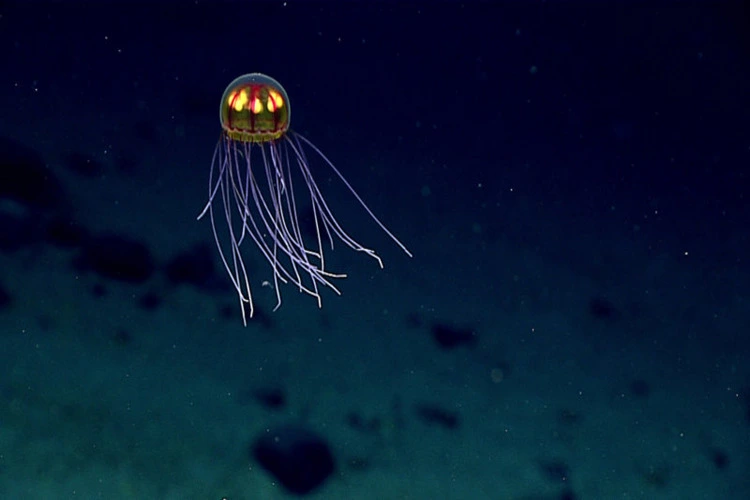
Take a deep dive into the fascinating creatures that live in the Mariana Trench, the deepest point on the planet
By
The Mariana Trench is the deepest point on the planet, plunging down to 10,984 metres (36,037 feet) in the Pacific Ocean. To put that into perspective, the entire of Mount Everest could fit into the trench, with two kilometres left between the water surface and the mountain’s summit.
Sunlight is unable to penetrate to the depths of the trench, and the pressure is so great – 1,100 times more than the Earth’s surface – that all human life would perish in its waters.
Yet despite the inhospitable conditions of the Mariana Trench, a vast array of species have adapted to its environment, slowly being discovered by scientists who using remotely operated vehicles (ROVs) to encounter these creatures.
So, what exactly lives in the waters of the Mariana Trench? Here we take a look at some of the animal species recently found at the world’s deepest point:
1) Dumbo octopus (Grimpoteuthis spp.)
This cute creature – named after the Disney character ‘Dumbo’ for its ear-like fins – is the deepest-living octopus known on the planet. Unlike many other octopuses, the Dumbo octopus (Grimpoteuthis spp.) does not possess an ink sac as it encounters so few predators in the Mariana Trench where it lives.
It feeds mainly on invertebrates that live in the ocean’s water column, such as krill. Typically, Dumbo octopus commonly grow to between 18 to 30cm (7 to 12 inches) long, but the largest individual ever recorded measured a staggering 1.8m (5.9 feet).
2) Mariana snailfish (Pseudoliparis swirei)
Discovered in 2017, the Mariana snailfish (Pseudoliparis swirei) is the deepest fish ever recorded in Earth’s oceans, found at 8,000m below the surface during an expedition to the Mariana Trench. These translucent creatures feast on tiny crustaceans and shrimp, clustering in groups as they glide along the ocean floor.
The fish is named to honour Herbert Swire, a navigational sub-lieutenant on the 1870s British expedition HMS Challenger. This expedition discovered various marine species, and eventually led scientists to finding the Mariana Trench itself.
Interested in the Mariana Trench? Check out our related reads…
- Bacteria near Mariana Trench ‘sense’ Earth’s magnetic field
- Geo explainer: Exploring the Mariana Trench
3) Jellyfish
It might look like a creature from another planet, but this jellyfish – not yet officially named by scientists – is one of the species that lives within the depths of the Mariana Trench. Discovered in 2016 during a NOAA expedition on the Enigma Seamount, the translucent jellyfish features two sets of tentacles, both short and long, and was found at a depth of 3,700m (12,140ft).
It is believed that the still, motionless behaviour of the jellyfish at the video’s beginning is the technique it uses to capture prey.
Think you know your geography? Score high enough and win a prize…
4) Supergiant amphipod (Hirondellea gigas)
These shrimp-like crustaceans were discovered to live in the Mariana Trench during a 2019 expedition to the waters’ depths. Scientists were eager to understand how these creatures could withstand the extreme pressures at such a depth, eventually discovering that the crustaceans use not only calcium but aluminium to strengthen their exoskeletons.
This makes them the first known species to use aluminium for such a purpose.
It is thought that the Supergiant amphipod can ingest aluminium through sediments on the seafloor, utilising it in a different form to coat its exterior. Such adaptations highlight what it takes for creatures to live in the Mariana Trench.
5) Giant single-celled organisms (Xenophyophores)
In research conducted into the Mariana Trench, scientists found single-celled organisms at its depths that were the same size as a mango. Measuring four inches (around 10 centimetres) long, these organisms were discovered at depths of 10.6km (6.6 miles) using dropcams – specialist cameras dropped into the ocean equipped with lights and recording devices.
Known as Xenophyophores, these sponge-like gigantic cells are well-adapted to the harsh environment of the trench but are very fragile and, thus, difficult to study.
Future research will need to be conducted to understand their adaptations to living in one of the harshest environments on the planet.
6) Sea cucumber (Holothuroidea spp.)
During a two-month-long expedition in 2016 – conducted by NOAA – researchers captured a violet sea cucumber above the sea floor in the Mariana Trench. The species never touch the sea floor, instead floating in the water column for their entire lives.
Sea cucumbers are well-adapted to survive in both deep ocean waters and shallower regions. Typically, the species feed on nutrients that they get from seafloor sediment, using ‘tube feet’ to suck up seafloor mud. Unsurprisingly, they are also known as the ‘vacuum cleaners of the sea’.



